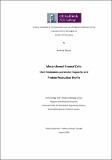| dc.contributor.advisor | Ceredig, Rhodri | |
| dc.contributor.author | Ribeiro, Andreia | |
| dc.date.accessioned | 2017-01-11T12:42:29Z | |
| dc.date.available | 2017-01-11T12:42:29Z | |
| dc.date.issued | 2016-08 | |
| dc.identifier.uri | http://hdl.handle.net/10379/6252 | |
| dc.description.abstract | The clinical benefits of mesenchymal stromal cell (MSC) based therapies for immune disorders and degenerative diseases are based on their combined ability to modulate the immune system and to differentiate into different end-stage mature cells. However there is a lack of a potency assay to measure this immunosuppressive property, thereby allowing a comparison of MSC sources, donors and passage number. Another important role of MSC is mediated by the extracellular matrix (ECM) that this cells produce, which can influence the hematopoietic environment. A decellularized MSC-derived ECM scaffold could also be used for tissue engineering and regenerative medicine. For this reason this project was divided into two main parts.
The first part, it was develop a rapid and reliable whole blood flow cytometry-based assay, where different parameters were tested. Following optimization, the efficiency of bone marrow MSC and adipose derive MSC to immunosuppress LPS activated peripheral blood monocytes were compared. In addition, blood samples were obtained from osteoarthritis or rheumatoid arthritis patients. With the whole blood assay it was also possible to characterized the immunogenic potential of different scaffolds and the immunosuppressive potential of seaweed extracts.
The second part comprised a comparison of two methods of preparing MSC-derived decellularized ECM prepared either in normoxic or hypoxic conditions. The main aim was to compare their composition and biological role on MSC differentiation and stemness properties.
For this, decellularized MS5 ECM was obtained either by osmotic shock using a hypotonic solution or by inducing apoptosis with a suicide gene. These matrices produced in normoxia or hypoxia were characterized and compared by immunocytochemistry, RT-PCR and proteomics. To better understand the role of ECM and hypoxia in MSC fate, mouse MSC were differentiated on top of different ECM.
This thesis brings together different areas of knowledge; cell biology, immunology, regenerative medicine and bioengineering, with the main aim of improving the clinical outcome of patients. | en_IE |
| dc.rights | Attribution-NonCommercial-NoDerivs 3.0 Ireland | |
| dc.rights.uri | https://creativecommons.org/licenses/by-nc-nd/3.0/ie/ | |
| dc.subject | Monocytes | en_IE |
| dc.subject | Extracellular matrix (ECM) | en_IE |
| dc.subject | Medicine | en_IE |
| dc.subject | Mesenchymal stromal cells (MSC) | en_IE |
| dc.subject | Immunosuppressive capacity | en_IE |
| dc.title | Mesenchymal stromal cells: their immunosuppressive capacity and protein production profile | en_IE |
| dc.type | Thesis | en_IE |
| dc.contributor.funder | People Programme (Marie Curie Actions) of the European Framework Programme FP7/2007-2013 under Research Executive Agency grant agreement No. 315902 | en_IE |
| dc.local.final | Yes | en_IE |
| nui.item.downloads | 235 | |


